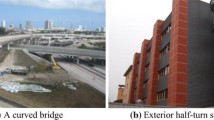Abstract
Fracture mechanics role within the framework of the ACI Building Code will be significant if fracture mechanics provides answers to public safety issues, and relatively insignificant if fracture mechanics only provides a different theoretical viewpoint for provisions which already provide an adequate margin of public safety. Public safety issues for which fracture mechanics can provide answers include size effects, appropriate finite element analyses procedures, new materials, minimum reinforcement ratios, maximum reinforcement spacings, and time dependent effects. Issues for which fracture mechanics can provide a consistent theoretical basis include the diagonal tension cracking capacity for shear, torsion, and combined shear and torsion loadings.
Access this chapter
Tax calculation will be finalised at checkout
Purchases are for personal use only
Preview
Unable to display preview. Download preview PDF.
Similar content being viewed by others
References
ACI Committee 318. Building Code Requirements for Reinforced Concrete (ACI 318–83). American Concrete Institute, Detroit, MI, (1983).
American Association of State Highway and Transportation Officials. Standard Specifications for Highway Bridges, 12th Edition, Washington D.C., (1977).
ASME Boiler and Pressure Vessel Code. Concrete Reactor Vessels and Containments, Section III, Division 2, American Society of Mechanical Engineers, New York, NY, (1983).
ACI Committee 344. Design and Construction of Circular Prestressed Concrete Structures, American Concrete Institute, Detroit, MI, (1970).
Hawkins, N.M. Impact of Research on Prestressed Concrete Specifications, Significant Developments in Engineering Practice and Research, American Concrete Institute, Detroit, MI, 1981.
Bazant, A.P. Size Effect in Blunt Fracture: Concrete, Rock, Metal, Engineering Mechanics Journal, ASCE, vol. 110, no. 4, (Apr. 1984).
ACI-ASCE Committee 426. The Shear Strength of Reinforced Concrete Members, Structural Division Journal, ASCE, (June 1973) 1148–1157.
Wecharatana, M and Shah, S.P. Nonlinear Fracture Mechanics Parameters, Fracture Mechanics of Concrete, Elsevier, NY, ( F.H. Wittman Editor, 1983 ) 463–480.
Walsh, P.F. Fracture of Plain Concrete, The Indian Concrete Journal, vol. 46, no. 11, (Nov. 1979) 469–470 and 476.
Hawkins, N.M., Wyss, A.N. and Mattock, A.H. Fracture Analysis of Cracking in Concrete Beams, Structural Division Journal, ASCE, vol. 103, no. STS, ( May 1977 ) 1015–1030.
Hsu, T.T.C. Torsion of Structural Concrete-Plain Concrete Rectangular Sections, S P-18, Torsion of Concrete, American Concrete Institute, Detroit, MI (1968).
Bazant, Z.P. and Cedolin, L. Blunt Crack Band Propagation in Finite Element Analysis, Engineering Mechanics Division Journal, ASCE, vol. 105, no. EM2, (Apr. 1979) 297–315.
ACI-ASCE Committee 426. Suggested Revisions to Shear Provisions for Building Codes, American Concrete Institute, Detroit, MI (1979).
Bazant, Z.P. and Oh, B.H. Spacing of Cracks in Reinforced Concrete, Structural Division Journal, ASCE, vol. 109, no. 9, (Sept. 1983) 2066–2085.
Gergeley, P. and Lutz, L.A. Maximum Crack Width in Reinforced Concrete Flexural Members, Causes, Mechanism, and Control of Cracking in Concrete, SP-20, American Concrete Institute, Detroit, MI (1968) 87–117.
Broms, B. B. Crack Width and Crack Spacing in Reinforced Concrete Members, ACI Journal, vol. 62, no. 10, (Oct. 1965) 1237–1256.
Hawkins, N.M., Lin, I.J. and Jeang, F.L. Local Bond Strength of Concrete for Cyclic Reversed Loadings, Proceedings International Conference on Bond in Concrete, College of Technology, Paisley, Scotland (P. Bartos Editor, 1982 ) 151–161.
Akutagawa, S. Wedge Configuration and Loading History Considerations for Concrete CLWL-DCB Fracture Specimens, MSCE Thesis, University of Washington (August 1984).
Cho, K.Z., Kobayashi, A.S., Hawkins, N.M., Barker, D.B. and Jeang, F.L. Fracture Process Zone of Concrete Cracks, Engineering Mechanics Division Journal, ASCE, vol. 110, no. 8 (August 1984) 1174–1184.
Collins, M.P. and Mitchell, D. Shear and Torsion Design of Prestressed and Non-prestressed Concrete Beams, PCI Journal, vol. 25, no. 5, (Sept./Oct. 1980 ) 32–101.
Wyss, A.N. Application of Fracture Mechanics to Cracking in Concrete Beams, Ph.D. Thesis, University of Washington (1971).
Mattock, A.H. Diagonal Tension Cracking in Concrete Beams with Axial Forces, Structural Division Journal, ASCE, vol. 95, no. ST9, (Sept. 1969).
Kobayashi, A.S., Hawkins, N.M., Barker, D.B. and Liaw, B.M. Fracture Process Zone of Concrete, Proceedings, NATO Advanced Research Workshop on Application of Fracture Mechanics to Cementitious Composites, Northwestern University, Evanston, IL (1984).
Taylor, H.P.J. Investigation of Dowel Shear Forces Carried by the Tensile Steel in Reinforced Concrete Beams, TRA 431, (Nov. 1969); Further Tests to Determine Shear Stresses in Reinforced Concrete Beams, TRA 438, (Feb. 1970); Investigation of the Forces Carried Across Cracks in Reinforced Concrete Beams in Shear by Interlock of Aggregate, TRA 447 (Nov. 1970) Cement and Concrete Association, Slough, Bucks.
Rajagopalan, K.S. and Ferguson, P.M. Exploratory Shear Tests Emphasizing Percentage of Longitudinal Steel, ACI Journal, vol. 65, no. 8 (Aug. 1968) 634–638.
Kani, G.N.J. Basic Facts Concerning Shear Failure, ACI Journal, vol. 63, no. 6 (June 1966) 675–692.
Kani, G.N.J. How Safe are Our Large Reinforced Concrete Beams? ACI Journal, vol. 64, no. 3 (May 1967) 128–141.
Mattock, A.H., Birkeland, C.J. and Hamilton, M.E. Strength of Reinforced Concrete Beams Without Web Reinforcement in Combined Torsion, Shear, and Bending, The Trend in Engineering, University of Washington, vol. 19, no. 4 (Oct. 1967) 8–12 and 29.
Ersoy, U. Combined Torsion in Semi-Continuous Concrete L-Beams Without Stirrups, Ph.D. Thesis, University of Texas (1965).
Author information
Authors and Affiliations
Editor information
Editors and Affiliations
Rights and permissions
Copyright information
© 1985 Martinus Nijhoff Publishers, Dordrecht
About this chapter
Cite this chapter
Hawkins, N.M. (1985). The Role for Fracture Mechanics in Conventional Reinforced Concrete Design. In: Shah, S.P. (eds) Application of Fracture Mechanics to Cementitious Composites. NATO ASI Series, vol 94. Springer, Dordrecht. https://doi.org/10.1007/978-94-009-5121-1_23
Download citation
DOI: https://doi.org/10.1007/978-94-009-5121-1_23
Publisher Name: Springer, Dordrecht
Print ISBN: 978-94-010-8764-3
Online ISBN: 978-94-009-5121-1
eBook Packages: Springer Book Archive




